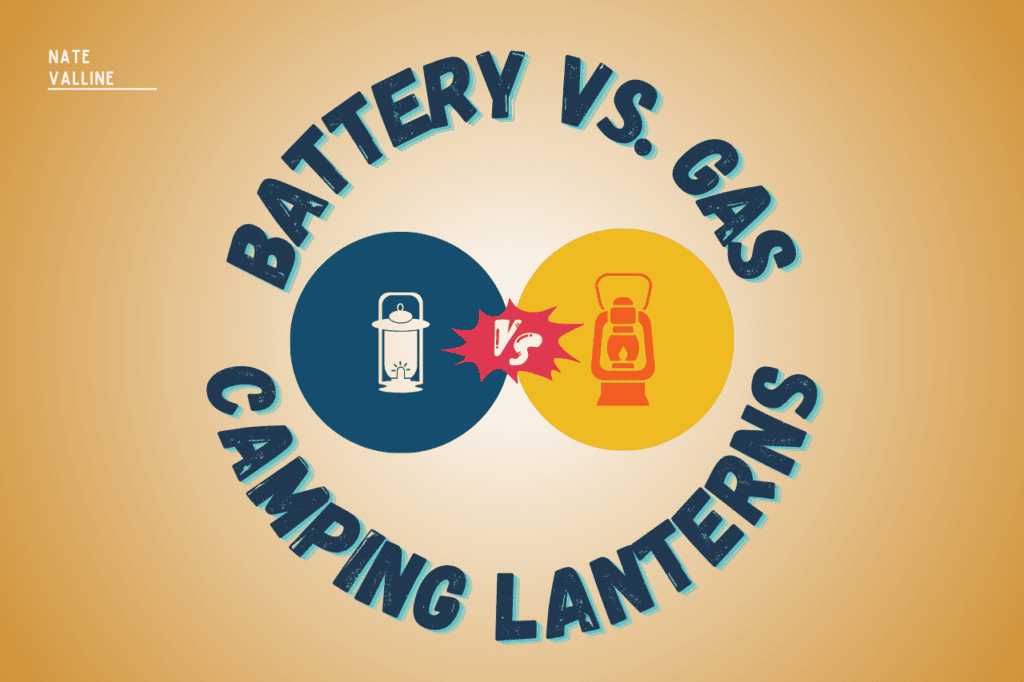
Few things are as crucial in the world of camping as a reliable light source when the sun sets. As technology advances, the debate between battery vs gas camping lanterns continues to evolve.
Are gas lanterns still relevant in 2024, or have battery-powered ones taken over?
Let’s examine the main differences between these two types of lanterns to help you decide to purchase the best camping lantern for your next outdoor adventure.
TL;DR:
- Explore the ongoing debate between battery-powered and gas-powered camping lanterns.
- Discover the advantages and disadvantages of each type.
- Consider factors like safety, convenience, brightness, and environmental impact.
- Find out if gas lanterns still have a place in camping gear in 2024.
The Main Differences Between Battery & Gas Powered Lanterns
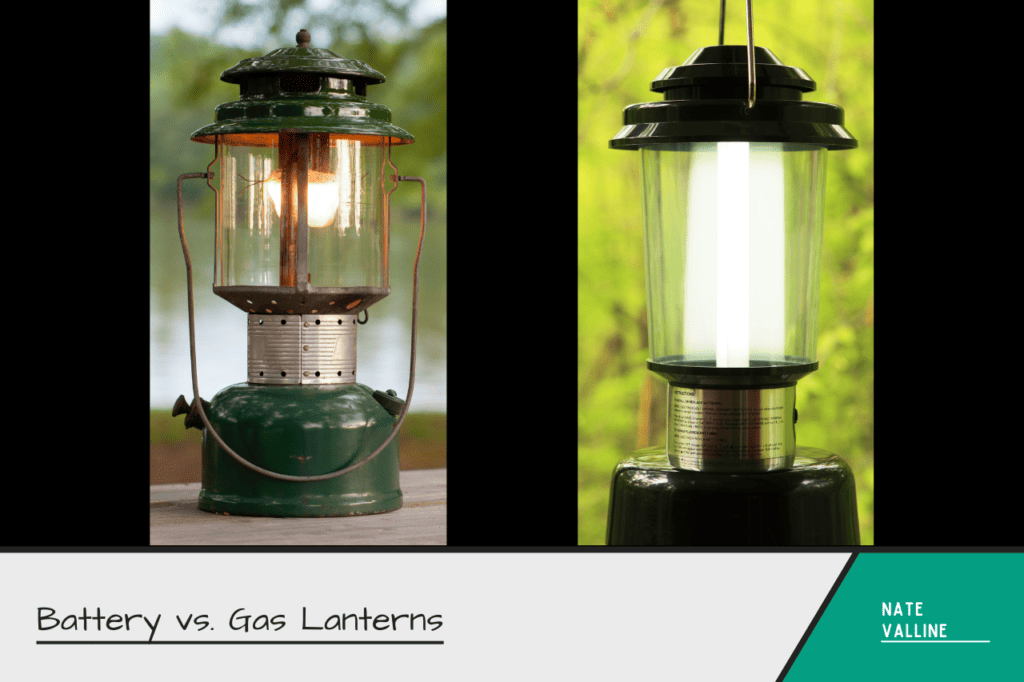
When comparing battery-powered and gas-powered lanterns, several key differences stand out.
Firstly, let’s talk about light output. Gas lanterns typically provide superior brightness compared to their electric counterparts. This brightness is often appreciated in larger camping areas or situations where visibility is paramount.
On the other hand, electric lanterns may offer various light settings but tend to have a more limited maximum brightness.
Another crucial factor to consider is safety, especially concerning flammable materials. Gas lanterns rely on combustible fuels, which can pose a fire hazard if not handled correctly.
In contrast, electric lanterns eliminate this risk as they operate without an open flame, making them safer to use in enclosed spaces or around children.
These differences in light output and safety are essential considerations when choosing between gas and electric lanterns for camping.
Depending on your specific needs and preferences, one type may be more suitable.
Battery-Powered Lanterns
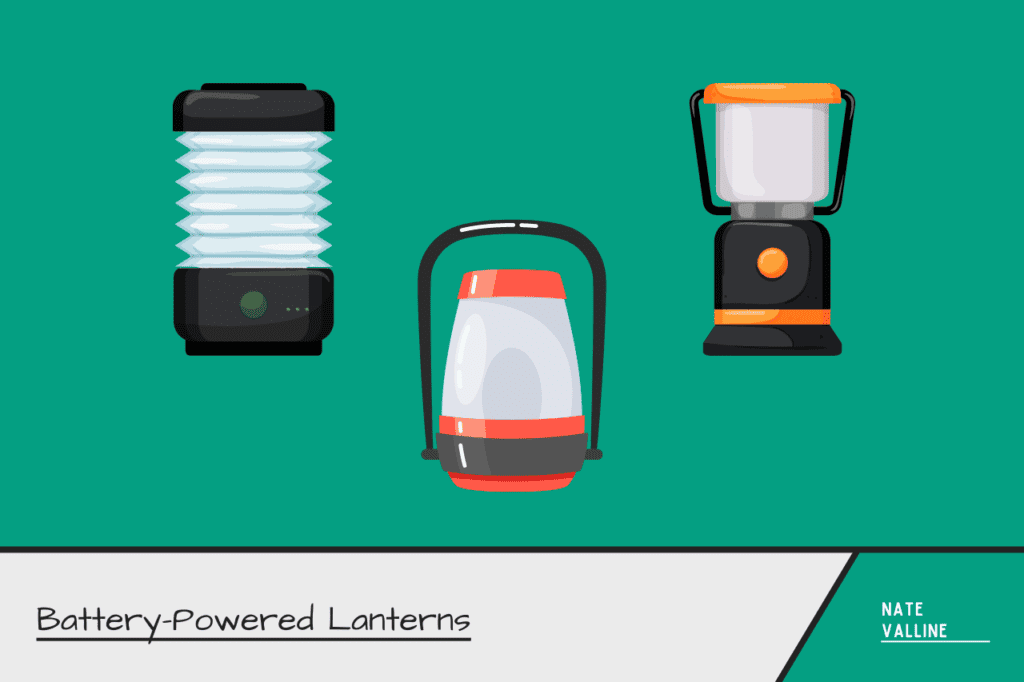
When it comes to illuminating your camping experience, battery-powered lanterns offer diverse options to suit every camper’s needs.
LED lanterns, for instance, have revolutionized the camping scene with their energy efficiency and long-lasting illumination. These lanterns often come equipped with various lighting modes, allowing you to adjust brightness levels according to your surroundings.
Additionally, solar lanterns harness the power of the sun, providing an eco-friendly and sustainable lighting solution for outdoor adventures.
Exploring the pros and cons of battery-powered lanterns can help you make an informed decision. While their portability and convenience make them popular among campers, there are considerations to consider.
Let’s dive deeper into the advantages and disadvantages of battery-powered lanterns to help you choose the perfect lighting companion for your next outdoor excursion.
Advantages of Battery-Powered Lanterns
Electric lanterns offer many advantages that enhance your camping experience. These versatile lanterns, equipped with efficient LED lights, provide ample illumination for your tent or campsite.
Their lightweight design makes them easy to carry, ensuring you can take them wherever your adventure leads.
Unlike gas-powered alternatives, electric LED lanterns operate quietly, allowing you to enjoy the serenity of nature without any noisy distractions.
Let’s explore the benefits of these convenient lighting solutions in more detail below.
Safety

Safety is paramount when selecting a suitable camping lantern, and electric options offer distinct advantages.
Unlike gas-powered lanterns, which rely on flammable fuels and open flames, battery-powered lanterns operate without any fire risk. This eliminates concerns about accidental fires, especially in confined spaces like tents or near other flammable materials.
Battery-powered lanterns offer campers peace of mind, knowing that their lighting source poses minimal safety hazards, making them an excellent choice for any outdoor adventure.
Convenience
Convenience is crucial when choosing a camping lantern, and electric options excel in this area. With their quiet operation and long battery life, these lanterns offer hassle-free lighting solutions for any outdoor excursion.
Unlike a gas camping lantern, which can be noisy and require frequent refueling, electric lanterns provide reliable illumination without any disruptions. Their long battery life ensures you can enjoy extended periods of light without constantly worrying about recharging or replacing batteries.
Portability

Portability is a standout feature of electric camping lanterns, making them an essential companion for any outdoor trip. These lanterns are designed to be lightweight and compact, allowing you to easily pack them for your next adventure.
Whether you’re embarking on a hiking expedition or setting up camp at a remote location, the portability of an electric camping lantern ensures that you can bring reliable lighting wherever your trip takes you. With their convenient size and weight, these lanterns offer unmatched convenience for campers on the go.
Light Options
Regarding light options, electric lanterns provide versatility to cater to various camping needs. These lanterns are equipped with advanced lighting modes and light-emitting diode (LED) technology that offer a spectrum of illumination choices.
From soft light for cozy evenings around the campfire to colorful accent light to bright beams for navigating dark trails, electric LED lanterns can adjust to any situation.
Their diverse light options ensure campers have the perfect lighting solution for every moment of their outdoor adventures, enhancing safety and ambiance in the wilderness.
Environmental Impact
Considering the environmental impact is crucial when selecting camping gear, and electric lanterns offer eco-friendly options. Solar lanterns, particularly, harness renewable energy from the sun, reducing reliance on traditional power sources and minimizing carbon footprints.
Additionally, many electric LED lanterns are compatible with rechargeable batteries, further decreasing waste and environmental harm.
By opting for solar lanterns or rechargeable battery-powered options, campers can enjoy the great outdoors while minimizing their environmental impact, contributing to a sustainable camping experience for future generations.
Disadvantages of Battery-Powered Lanterns
While electric lanterns offer numerous benefits, it’s essential to consider their potential drawbacks. One concern is whether they provide enough light for camping needs, especially in larger outdoor areas.
Additionally, in cold weather conditions, the performance of some battery-powered lanterns may be affected, leading to reduced efficiency or shorter battery life.
Understanding these disadvantages will help you decide when selecting the right lighting solution for your camping adventures.
Let’s explore these drawbacks in more detail below.
Limited Brightness
One notable disadvantage of electric lanterns is their limited brightness compared to gas-powered alternatives.
While electric lanterns offer sufficient illumination for many camping scenarios, they may need help to match the intense brightness provided by gas-powered lanterns, particularly in larger outdoor spaces.
This limitation can affect visibility during nighttime activities or when navigating rugged terrain. Campers who prioritize maximum brightness may find gas-powered lanterns more suitable.
However, advancements in LED technology continue to improve the brightness of electric lanterns, offering promising solutions for future outdoor lighting challenges.
Battery Life
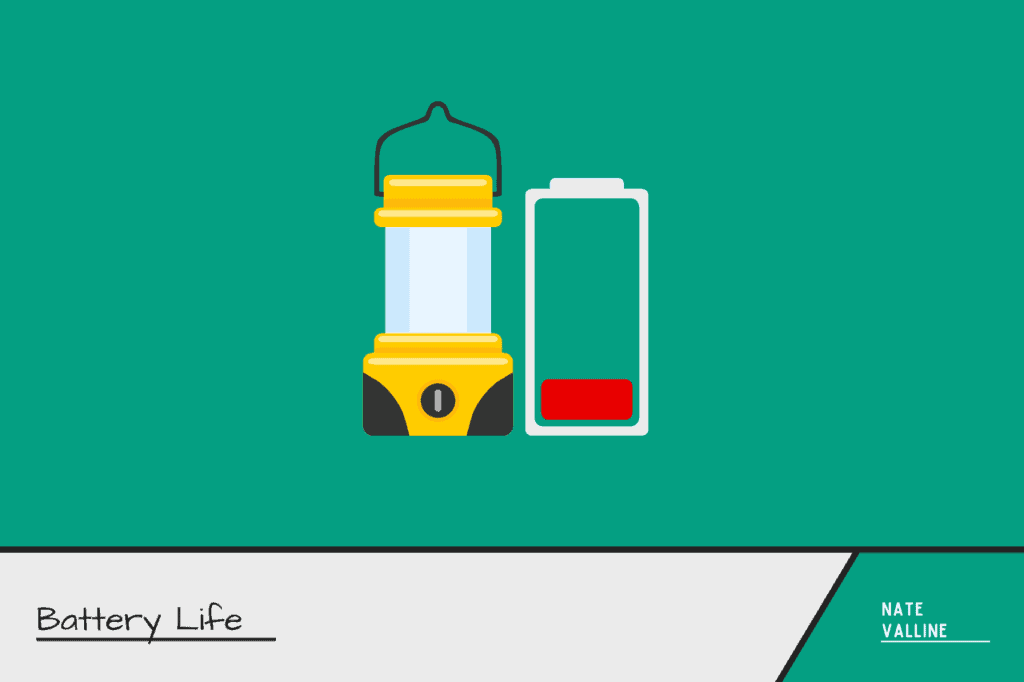
Electric lanterns’ battery life is a significant concern, impacting illumination duration during camping trips. While modern lithium batteries have improved in longevity, extended use or high brightness settings can quickly drain power.
Campers relying solely on electric lanterns must plan accordingly, ensuring they have an adequate supply of spare batteries or alternative charging methods.
Additionally, cold weather can further reduce battery life, posing challenges for camping in chilly environments.
Cost of Batteries
The cost of batteries can be a significant factor to consider when opting for electric lanterns. While the initial purchase of the lantern may seem reasonable, the ongoing expense of purchasing batteries can add up over time, especially for frequent campers.
Depending on usage frequency and the type of batteries required, lithium vs. alkaline, the cost can become a recurring expense, impacting the affordability of using battery-powered lanterns.
Campers should weigh the convenience of battery-powered lighting against the long-term financial implications of continuously purchasing batteries to ensure they make a cost-effective choice for their camping needs.
Gas-Powered Lanterns
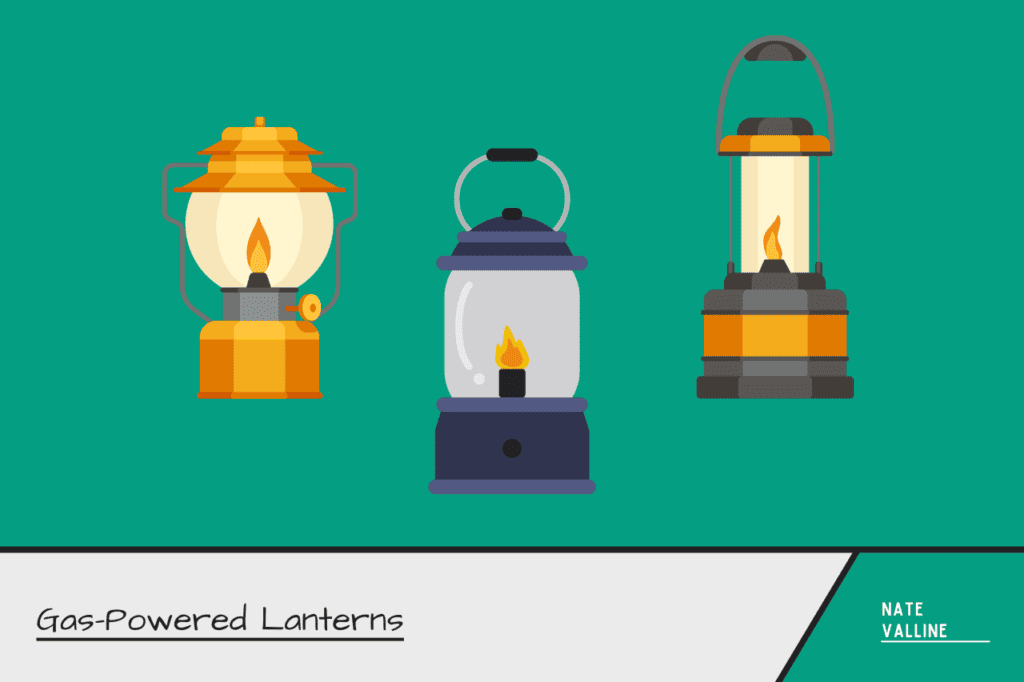
Regarding traditional camping lighting options, gas-powered lanterns remain popular among outdoor enthusiasts. These fuel-burning lanterns, often fueled by liquid fuel or propane, offer reliable illumination in remote camping locations where access to electricity may be limited.
Unlike electric alternatives, gas-powered lanterns utilize mantles to produce a bright, consistent light that closely mimics natural sunlight, creating a warm ambiance around the campsite.
While they require careful handling due to the use of flammable fuels, gas-powered lanterns are prized for their longevity and ability to provide ample illumination throughout extended camping trips.
In the sections below, we will explore the pros and cons of using gas-powered lanterns for outdoor adventures.
Advantages of Gas-Powered Lanterns
Gas-powered lanterns offer a range of advantages that make them a preferred choice for many campers. One key advantage is their natural, soft light, creating a cozy ambiance reminiscent of traditional campfires.
Propane lanterns, in particular, are known for their reliability and ease of use, making them a popular option for outdoor enthusiasts.
Whether setting up camp in the wilderness or enjoying a backyard barbecue, gas-powered lanterns provide dependable illumination that enhances the outdoor experience. Let’s explore the advantages of these versatile lanterns in more detail below.
Superior Brightness
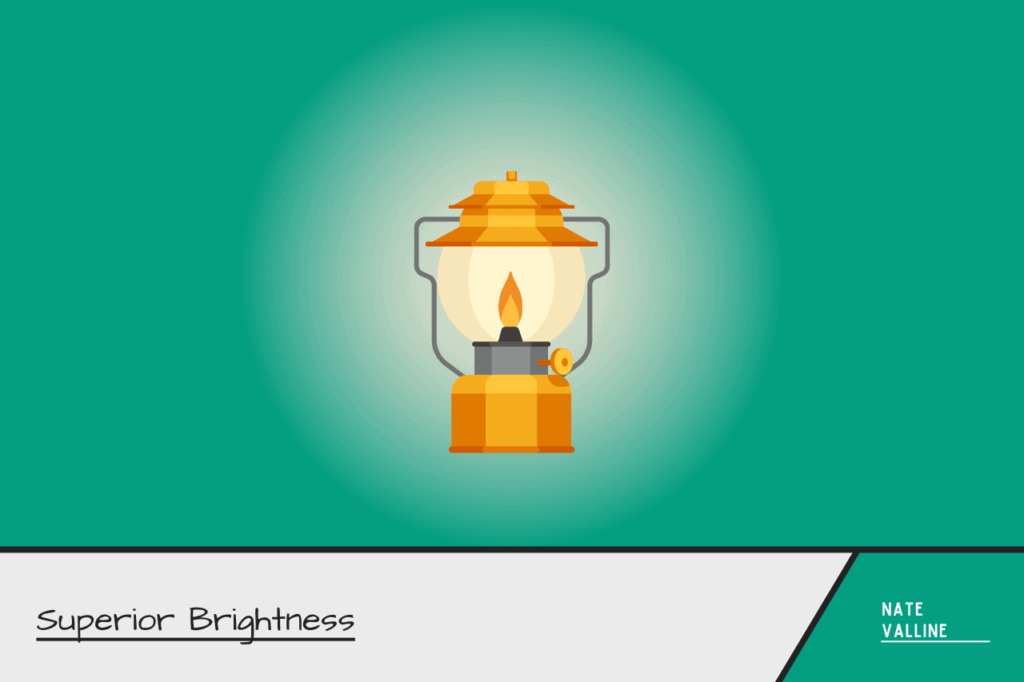
One advantage of gas-powered lanterns is their superior brightness, unmatched by many other lighting options. Typically fueled by white gas or propane, these lanterns produce a powerful and intense light that easily illuminates large areas.
The use of mantles further enhances the brightness, creating a radiant glow that closely resembles natural daylight.
Whether you’re cooking dinner at the campsite or enjoying nighttime activities, gas lanterns’ superior brightness ensures optimal visibility and enhances the overall outdoor experience.
Long Burn Time
Gas lanterns are renowned for their long burn time, making them ideal for extended camping trips or nights spent outdoors. With a single fill of fuel, gas lanterns can provide hours of continuous illumination, ensuring you have light throughout the night without the need for frequent refueling or battery changes.
This long burn time is especially advantageous when backpacking in remote locations where access to additional fuel or batteries may be limited.
Campers can rely on gas lanterns to provide consistent light, allowing them to enjoy their outdoor adventures well into the night.
Fuel Versatility
One notable advantage of gas-powered lanterns is their fuel versatility, which offers campers a wide range of options to suit their preferences and availability.
Gas lanterns can efficiently burn various types of fuel, such as propane, white gas, kerosene, gasoline, or butane, providing flexibility for campers in different environments.
Additionally, some models feature compatibility with disposable canisters or refillable tanks, further enhancing convenience and accessibility for outdoor enthusiasts.
This fuel versatility ensures that campers can easily find and use the most suitable fuel option for their specific camping needs, maximizing the efficiency and convenience of gas-powered lanterns.
Ambiance

The ambiance created by gas-powered lanterns is unmatched, adding a touch of warmth and nostalgia to any outdoor setting. The soft, flickering glow produced by these lanterns evokes the charm of traditional camping experiences, creating a cozy atmosphere that enhances the overall enjoyment of outdoor adventures.
Whether you’re gathered around a campfire with friends or enjoying a quiet evening under the stars, the gentle illumination provided by gas lanterns sets the perfect mood for relaxation and camaraderie. Campers seeking to recreate the classic camping ambiance will appreciate the timeless appeal of gas-powered lanterns.
Disadvantages of Gas-Powered Lanterns
While gas-powered lanterns offer numerous benefits, knowing their potential drawbacks is essential to making an informed decision for your camping needs.
One concern is the heat generated by these lanterns, which can pose a safety risk, especially in enclosed spaces like tents.
Additionally, some gas lanterns may emit noise during operation, potentially disrupting the tranquility of the camping environment. Their bulkiness can also make them less convenient to transport and store than their electric counterparts.
Understanding these disadvantages will help you effectively weigh the pros and cons of gas-powered lanterns. Let’s explore these drawbacks further below.
Safety Concerns

Safety concerns are paramount when using a gas lantern, as it poses potential risks, especially in confined spaces or near flammable materials.
One significant risk is the emission of carbon monoxide, a colorless and odorless gas that can be harmful or even fatal if inhaled in high concentrations. Using gas lanterns in well-ventilated areas is crucial to minimize the risk of carbon monoxide buildup.
Additionally, proper maintenance and careful handling of the lantern, including monitoring leaks and ensuring secure fuel connections, are essential for preventing accidents and providing a safe camping experience.
Maintenance
Maintenance is essential to owning a gas camp lantern to ensure optimal performance and longevity.
Regular maintenance tasks include replacing mantles, which can deteriorate over time and affect the quality of light emitted by the lantern. Additionally, cleaning the lantern’s components, such as the glass globe and fuel system, helps prevent debris buildup and ensures proper functionality.
By staying proactive with maintenance routines, campers can extend the lifespan of their gas lanterns and enjoy reliable illumination during their outdoor adventures without interruptions.
Weight and Bulk
Weight and bulkiness are notable considerations when choosing fuel-burning lanterns for camping adventures. Gas lanterns, while efficient and reliable, tend to be heavier and bulkier than their electric counterparts.
This can pose challenges when packing for trips where space and weight are limited, such as backpacking or hiking excursions.
Campers must factor in the additional weight and space requirements of a gas lantern and disposable canisters when planning their gear, balancing the benefits of their performance against the practicalities of transport and storage during outdoor expeditions.
Environmental Impact
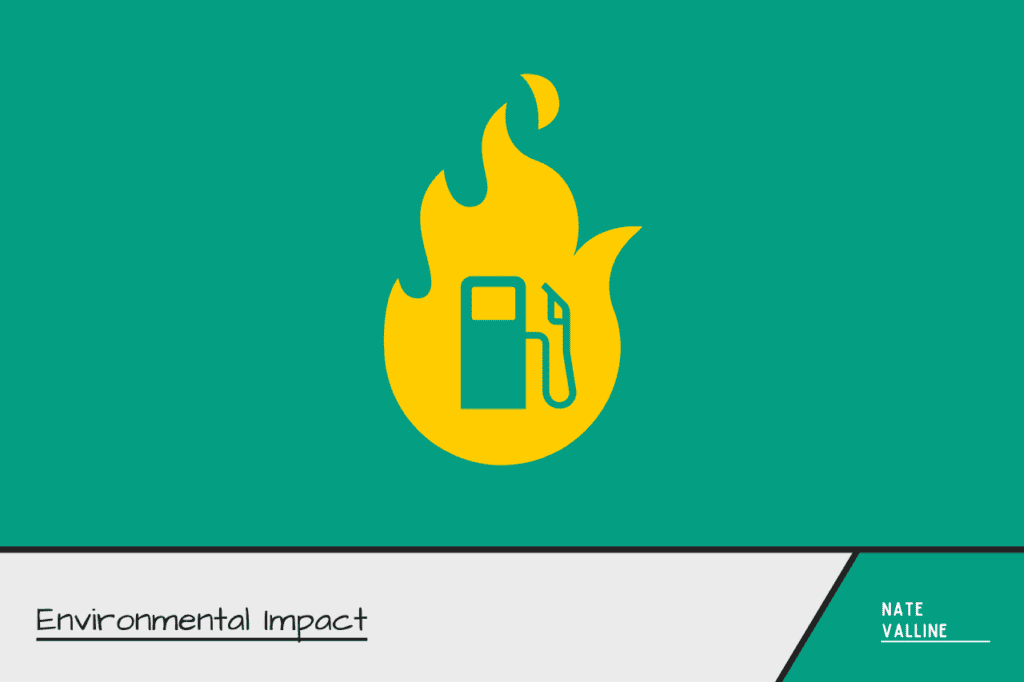
Considering the environmental impact is crucial when evaluating fuel-burning lanterns for camping. While effective, gas camping lanterns contribute to air pollution through the combustion of fossil fuels. The emissions produced, including carbon dioxide and other pollutants, can adversely affect local air quality and ecosystems.
Additionally, if not handled properly, the disposal of fuel canisters or liquid fuels may contribute to environmental degradation.
Campers concerned about minimizing their environmental footprint may opt for alternative lighting solutions, such as electric or solar-powered lanterns, to reduce their impact on the natural environment.
Battery vs Gas Camping Lanterns Considerations

When it comes to selecting the ideal camping lantern, weighing the considerations between battery-powered and gas-powered options is essential for ensuring a successful outdoor adventure. Both types offer distinct advantages and drawbacks that campers should carefully evaluate before deciding.
Electric lanterns excel in convenience, portability, and safety, making them an excellent choice for casual campers or those seeking hassle-free lighting solutions.
On the other hand, fuel-burning lanterns boast superior brightness, long burn times, and ambiance, ideal for campers who prioritize performance and traditional camping experiences.
Factors such as environmental impact, cost, and fuel availability also significantly influence the decision-making process.
By contemplating these factors and aligning them with individual camping preferences and needs, campers can choose the perfect lighting companion to illuminate their outdoor journeys comfortably and efficiently.
What About Solar Lanterns?

As technology advances, solar lanterns have emerged as a compelling alternative to traditional camping lighting solutions. These innovative lanterns offer an eco-friendly and sustainable option for campers seeking to reduce their environmental footprint by harnessing the sun’s power.
Solar lanterns utilize photovoltaic cells to convert sunlight into electricity, storing it in built-in batteries for nighttime use. This renewable energy source eliminates the need for disposable batteries or fuel, making solar lanterns a cost-effective and environmentally conscious choice.
Solar lanterns often feature durable and weather-resistant designs, ideal for outdoor use in various conditions. While they may require ample sunlight for optimal charging, solar lanterns provide a reliable lighting source for campers who prioritize sustainability and self-sufficiency.
Wrapping Up
To wrap things up, the debate about battery vs. gas camping lanterns continues to evolve, with each offering unique pros and cons for campers to weigh. While electric lanterns excel in terms of safety, convenience, and environmental impact, fuel-burning lanterns boast superior brightness, long burn times, and ambiance.
Additionally, the emergence of solar lanterns presents an eco-friendly alternative for campers seeking sustainable lighting solutions and potentially lower overall costs.
As you plan your next outdoor adventure, carefully consider your camping needs and preferences to choose the perfect lighting companion. Whether you opt for the convenience of battery-powered camp lanterns, the performance of gas-powered camp lanterns, or the sustainability of solar lanterns, ensure your camping experience is illuminated with comfort and efficiency.
Please check out our other camping blog posts for more camping tips and gear recommendations.
Happy camping!
Our camping blog is your compass to wilderness knowledge!
Your gateway to diverse topics and timeless insights!
